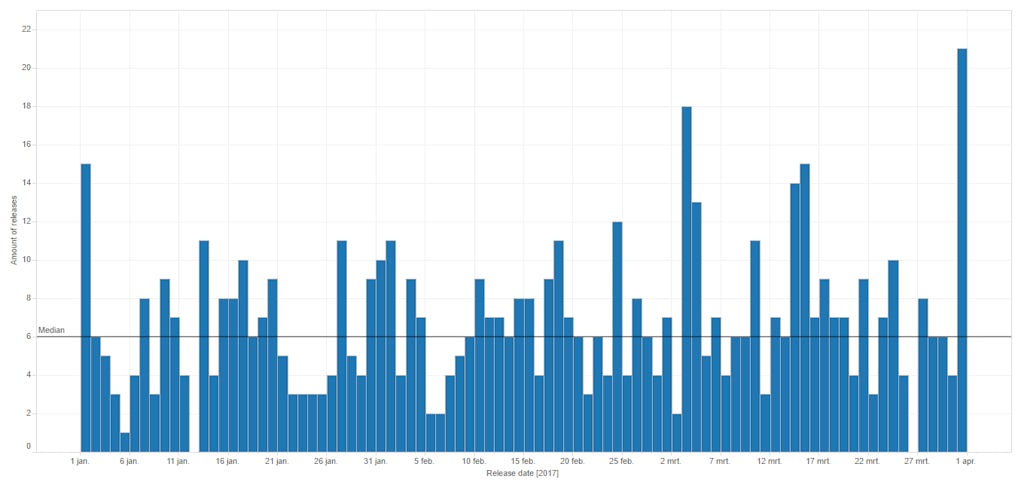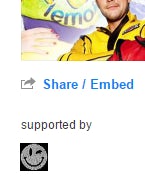
Bandcamp Belgium
Looking at 2017 first quarter (January — March)
Introduction
Although the music collection of Flanders Arts Institute currently still focuses on physical releases, we are actively investigating the other ways in which musicians are producing, distributing and promoting their music. So, I wanted to learn more about digital releases, and considered Bandcamp the first platform to investigate in some more detail. Of course, there are many other self-publishing music platforms (Soundcloud, Beatport, Juno Download …), but after some desktop research, I had the impression that Bandcamp was among the more popular ones.
Of course, each platform is unique and has its own dynamics, so let’s not generalize any first observations that I make here to other platforms or to digital music in general!
The data
I am one of the data guys (and girls) at Flanders Arts Institute, so I decided to just grab the data from Bandcamp. Basically, on a weekly basis I scraped the “new arrivals” pages for tags that relate to Belgium, Flanders and cities within Flanders. This gives me a perspective on the Bandcamp releases of artists that self-report a location in Belgium. I am aware of the fact that I am missing releases from artists who do not reveal their location, but given that caveat, I guess I can get a “general perspective”. For each release, I capture the title, the artist, the format of the release (digital, CD, vinyl, cassette), the release date — which turns out to be a weird concept in a digital age — and the tags that the artists connected with the release. So, for three months, I ran the script and now I have a view on the Bandcamp releases of Quarter 1 (January 1 until March 31) of 2017 that were also announced on Bandcamp in that period. I am thus ignoring the “back catalogue” releases that are being uploaded, as well as the early release announcements.
Take a look at the data, download it, and browse through some visualizations on my Tableau Public profile.
The sheer amount
A first observation is simply the sheer amount of releases that pass by. On average (median) there are 6 releases each day, or about 40 per week! And that is only for Belgium, which is a pretty small country. Who can, reasonably, keep track of this volume?

Tags
Never thought I’d produce a tag cloud — I am a computational linguist and abhor the concept of a word cloud — but here it is relevant to make one: tags assigned to Bandcamp releases, with bigger tags being the more frequent ones.

It turns out that the most frequently used tags indicate that Bandcamp is an online platform for first and foremost independent music in the styles of pop, rock, jazz, hip-hop, punk, metal, and experimental/instrumental stuff. Not a lot of classical music, dance (they have their own platforms like Beatport and Juno Download) and flemish popular music (are they on the digital bandwagon already?) to be seen.
Labels
I made a small algorithm that guesstimates whether or not a release was done by a label. Sometimes it is easy if labels use the “label” account of Bandcamp. But very often, this is not the case. My algorithm checks if the artist of the release corresponds to the Bandcamp artist that curates the release page. If it does not corresponds, it is either a label, or a Bandcamp artist that uses several aliases.
After the first quarter, I ended up with about 120 potential labels. Some colleagues and I went through that list and made a judgement call, dividing the potential labels in “not a label” (the aliases case), “microlabel” (a very limited set of artists under the label), “national label” (a label representing several artists and publishing several releases located in Belgium), “international label” (same, but not in Belgium). Note that major labels are not on Bandcamp, so I have not included them in this typology here.
Below a visualization of microlabels (green), national (orange) and international (blue) labels. The size of the bubble indicates the amount of releases that were published on Bandcamp in Q1 of 2017. An interactive version of this viz is available on Tableau Public, so you can hover over the bubbles without a name to see who it is.

Getting support

One of the things I could do after the end of the quarter was to go back through the releases and see which ones already received support from Bandcamp members. I did this on April 4. If a Bandcamp member buys a track or release, a little symbol appears on the page. Note that this symbol does not appear if a non-Bandcamp member buys a track. So, the absence of a symbol does not necessarily implies that the track or release was never bought. But okay, it gives an indication of what is going on. It turns out that about half of the releases (283 out of almost 600) that appeared on Bandcamp in the first quarter already managed to get at least 1 Bandcamp member to support them by the end of the quarter. I was surprised, but colleagues pointed out that it is probably mom and dad, and then the drummer who buys a track. Does this then mean that about half of the artists on Bandcamp can not get their friends to buy a track?
Some remarks
Release dates
The concept of a release date is irrelevant on Bandcamp. There are Bandcamp artists who put the release date somewhere in the future, like the guys of Your Face Offends Me. Or there are Bandcamp artists who put down a release date, but also promise to update their releases because they continue working on the tracks. And then there are the labels, e.g. Alfa Matrix and artists that are uploading their entire back catalogue, and these releases appear in the “new arrivals” list, too. Or what about the Stilll label, stopped in 2010, that has uploaded old work, but did not put backdated release dates.
Fleeting
Another remark is that people are also free to take down there releases from Bandcamp, and that this made things a little bit difficult for me. So I see a release passing by on my weekly scrapes, but after a couple of weeks the release is gone again. This happened in not too many cases, but in a noteable amount. For the current analysis, we are going to leave out these fleeting releases, but this volatile aspect of a release is a fundamental difference with a physical release.
Everybody is professional, or an amateur
Because of the template-driven design of Bandcamp, all pages look more or less the same — although some artists manage them to be different. At first sight, it is hard to make a distinction between a page from an established label or a microlabel that works to appear as an independent and alternative organisation (on the term microlabel, check Belgium Underground). And also pages of bedroom producers or music enthusiasts look like that. Therefore, it is seems to be pretty tough to stand apart visually. It’s a good idea to invest in promotion outside Bandcamp to bring people to your Bandcamp page, because there are so many releases on Bandcamp that it is hard to stand out.
Overview
An overview of all the releases that I encountered in the first quarter can be found on Public Tableau. I tried to follow all the artists that passed by on my Bandcamp page, amounting to almost 650 Bandcamp artists. Feel free to browse, and let me know if I missed your release with release date between 1/1/2017 and 31/3/2017, while the release was put on Bandcamp in the same period.






